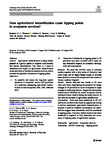Does agricultural intensification cause tipping points in ecosystem services?
| dc.contributor.author | Watson, SCL | |
| dc.contributor.author | Newton, AC | |
| dc.contributor.author | Ridding, LE | |
| dc.contributor.author | Evans, PM | |
| dc.contributor.author | Brand, Steven | |
| dc.contributor.author | McCracken, M | |
| dc.contributor.author | Gosal, AS | |
| dc.contributor.author | Bullock, JM | |
| dc.date.accessioned | 2022-01-18T12:31:23Z | |
| dc.date.available | 2022-01-18T12:31:23Z | |
| dc.date.issued | 2021-08-25 | |
| dc.identifier.issn | 0921-2973 | |
| dc.identifier.issn | 1572-9761 | |
| dc.identifier.uri | http://hdl.handle.net/10026.1/18575 | |
| dc.description.abstract |
Abstract Context Agricultural intensification is being widely pursued as a policy option to improve food security and human development. Yet, there is a need to understand the impact of agricultural intensification on the provision of multiple ecosystem services, and to evaluate the possible occurrence of tipping points. Objectives To quantify and assess the long-term spatial dynamics of ecosystem service (ES) provision in a landscape undergoing agricultural intensification at four time points 1930, 1950, 1980 and 2015. Determine if thresholds or tipping points in ES provision may have occurred and if there are any detectable impacts on economic development and employment. Methods We used the InVEST suite of software models together with a time series of historical land cover maps and an Input–Output model to evaluate these dynamics over an 85-year period in the county of Dorset, southern England. Results Results indicated that trends in ES were often non-linear, highlighting the potential for abrupt changes in ES provision to occur in response to slight changes in underlying drivers. Despite the fluctuations in provision of different ES, overall economic activity increased almost linearly during the study interval, in line with the increase in agricultural productivity. Conclusions Such non-linear thresholds in ES will need to be avoided in the future by approaches aiming to deliver sustainable agricultural intensification. A number of positive feedback mechanisms are identified that suggest these thresholds could be considered as tipping points. However, further research into these feedbacks is required to fully determine the occurrence of tipping points in agricultural systems. | |
| dc.format.extent | 3473-3491 | |
| dc.language | en | |
| dc.language.iso | en | |
| dc.publisher | Springer | |
| dc.title | Does agricultural intensification cause tipping points in ecosystem services? | |
| dc.type | journal-article | |
| dc.type | Journal Article | |
| plymouth.issue | 12 | |
| plymouth.volume | 36 | |
| plymouth.publication-status | Published | |
| plymouth.journal | Landscape Ecology | |
| dc.identifier.doi | 10.1007/s10980-021-01321-8 | |
| plymouth.organisational-group | /Plymouth | |
| plymouth.organisational-group | /Plymouth/Faculty of Arts, Humanities and Business | |
| plymouth.organisational-group | /Plymouth/REF 2021 Researchers by UoA | |
| plymouth.organisational-group | /Plymouth/REF 2021 Researchers by UoA/UoA17 Business and Management Studies | |
| plymouth.organisational-group | /Plymouth/Users by role | |
| plymouth.organisational-group | /Plymouth/Users by role/Academics | |
| dcterms.dateAccepted | 2021-08-03 | |
| dc.rights.embargodate | 2022-1-19 | |
| dc.identifier.eissn | 1572-9761 | |
| dc.rights.embargoperiod | Not known | |
| rioxxterms.versionofrecord | 10.1007/s10980-021-01321-8 | |
| rioxxterms.licenseref.uri | http://www.rioxx.net/licenses/all-rights-reserved | |
| rioxxterms.licenseref.startdate | 2021-08-25 | |
| rioxxterms.type | Journal Article/Review |


